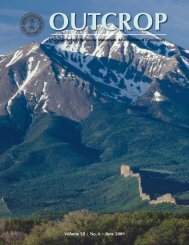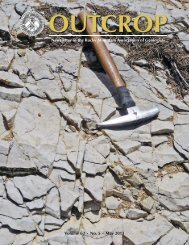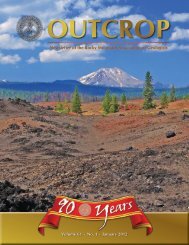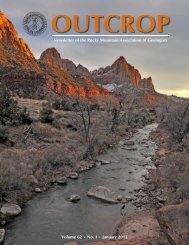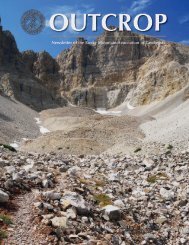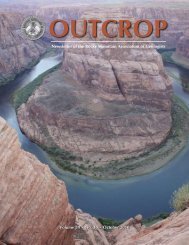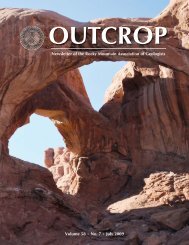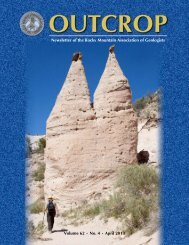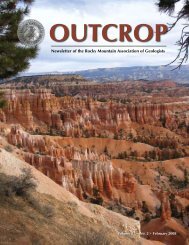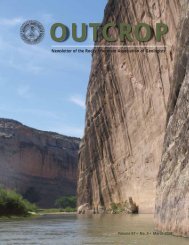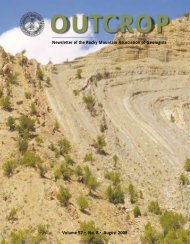May 2012 - Rocky Mountain Association of Geologists
May 2012 - Rocky Mountain Association of Geologists
May 2012 - Rocky Mountain Association of Geologists
Create successful ePaper yourself
Turn your PDF publications into a flip-book with our unique Google optimized e-Paper software.
OUTCROP<br />
Newsletter <strong>of</strong> the <strong>Rocky</strong> <strong>Mountain</strong> <strong>Association</strong> <strong>of</strong> <strong>Geologists</strong><br />
Volume 61 • No. 5 • <strong>May</strong> <strong>2012</strong>
Build reservoir analyses.<br />
Watch your potential soar.<br />
IHS PETRA ® provides a unique solution to integration, analysis and manipulation <strong>of</strong> geological, geophysical,<br />
petrophysical and engineering information. With easy data loading and a powerful and flexible database, you<br />
can both effectively manage projects and quickly visualize results using interactive mapping, cross sections,<br />
log plots, cross plots and more—all within a single system. Superior technical support and proven integration<br />
<strong>of</strong> customer enhancements make PETRA the highest-ranked 1 geological interpretation tool in the E&P industry<br />
for both reliability and accuracy and ease <strong>of</strong> use. Energy information, refined.<br />
1<br />
Welling & Company Geological & Geophysical S<strong>of</strong>tware Study, 2009<br />
Directional Well Module<br />
3D Visualization Module<br />
ihs.com/petra-rmag<br />
©2010 IHS Inc. All rights reserved.<br />
Vol. 61, No. 4 2<br />
April <strong>2012</strong>
OUTCROP<br />
Newsletter <strong>of</strong> the <strong>Rocky</strong> <strong>Mountain</strong> <strong>Association</strong> <strong>of</strong> <strong>Geologists</strong><br />
CONTENTS<br />
Features<br />
6 Lead Story: Welcome to<br />
Grand Junction!<br />
20 REVIEW: Why We Hate the<br />
Oil Companies<br />
24 AAPG Emblem Contest<br />
association news<br />
8 RMAG Celebrating Ninety<br />
Years <strong>of</strong> Service to the<br />
Geologic Community<br />
12 <strong>2012</strong> Award <strong>of</strong> Excellence<br />
for Teaching <strong>of</strong> Earth<br />
Science<br />
14 Summit Sponsorship Sign<br />
Up Today<br />
15 Summit Sponsors<br />
23 Earth Scientists – Publish<br />
Your Paper in The<br />
<strong>Mountain</strong> Geologist!<br />
26 On-the-Rocks Field Trips<br />
28 From the <strong>May</strong>, 1977<br />
Outcrop<br />
29 The Outcrop Needs YOU!<br />
30 Call for Papers: The<br />
<strong>Mountain</strong> Geologist<br />
32 <strong>2012</strong> RMAG Golf<br />
Tournament at Fossil<br />
Trace<br />
34 Field Trip Photos from<br />
1977<br />
Departments<br />
4 RMAG March Board <strong>of</strong><br />
Directors Meeting<br />
10 President's Column<br />
16 New Members<br />
18 Luncheon Program<br />
21 In the Pipeline<br />
35 Advertisers Index<br />
35 Calendar <strong>of</strong> Events<br />
COVER PHOTO<br />
White House Cliff dwellings in aeolian<br />
sandstones <strong>of</strong> the Permian De Chelly<br />
Formation. Photo by Phil Winner.<br />
OUTCROP<br />
3<br />
Volume 61 • No. 5 • <strong>May</strong> <strong>2012</strong><br />
www.rmag.org
RMAG March Board <strong>of</strong> Directors Meeting<br />
By Kimberley Alanis, Secretary (Kimberley.Alanis@qepres.com)<br />
The Board <strong>of</strong> Directors meeting was held on March<br />
21, <strong>2012</strong> in the RMAG <strong>of</strong>fice board room. The meeting<br />
started out with a review <strong>of</strong> February’s income and<br />
expenses. I am happy to report that we are continuing<br />
to increase our income considerably from the same time<br />
last year. The increase is largely due to the sponsorship<br />
“Summit" program, along with the registration for the<br />
3-D Seismic Symposium. Our expenses are still down<br />
from last year, as well. We plan to continue the year with<br />
a positive financial report.<br />
The Continuing Education Committee reported<br />
that they have lunch talks scheduled through June. As<br />
a reminder, in order to keep the cost to our members<br />
down, RMAG has decided to move the luncheon talks<br />
from the Marriott City Center to the Sheraton Hotel<br />
starting in June. We can look forward to the fall short<br />
course with a horizontal drilling and fracture theme in<br />
October. There is potential talk <strong>of</strong> having a “Legends <strong>of</strong><br />
Geology” event, possibly an evening series. More details<br />
<br />
<br />
about this potential event will follow next month. RMAG<br />
members would have the opportunity to listen to the<br />
stories and meet some <strong>of</strong> the greatest geologist in our<br />
community. Without a doubt, I would look forward to<br />
this event. For me, it would be like a young basketball<br />
player meeting Michael Jordan!<br />
The Publications Committee reported that they have<br />
sold over 130 publications this year. RMAG has decided<br />
to reduce the price <strong>of</strong> some publications during RMAG<br />
events. Please look for discounts at the RMAG table<br />
and pick up your favorite publication at a discount. The<br />
<strong>Mountain</strong> Geologist should have a couple great issues<br />
coming out shortly. For all you social media members,<br />
RMAG has created Facebook and Twitter pages. Keep<br />
your eyes out for upcoming events through them.<br />
The meeting included the approval <strong>of</strong> a couple<br />
motions, including the decision to discount some<br />
publication during RMAG events. I have to give credit to<br />
Pete Varney (President), he keeps the meeting moving<br />
and everything gets addressed resulting in another short<br />
and sweet board meeting.<br />
The RMAG Golf Tournament, which will be held on<br />
June 28th at Fossil Trace this year, sold out in 6 days.<br />
Thank you to all who have registered. We cannot wait<br />
to see you out there!<br />
The April Board <strong>of</strong> Director’s meeting was held<br />
on Wednesday, April 18th, at the University Building<br />
conference room on the 11th floor. The <strong>May</strong> meeting<br />
will be held <strong>May</strong> 16th at the same location.<br />
»<br />
<br />
<br />
<br />
Vol. 61, No. 4<br />
4<br />
April <strong>2012</strong>
OUTCROP<br />
The <strong>Rocky</strong> <strong>Mountain</strong> <strong>Association</strong> <strong>of</strong> <strong>Geologists</strong><br />
910 16th Street • Suite 1125 • Denver, CO 80202 • 303-573-8621<br />
The <strong>Rocky</strong> <strong>Mountain</strong> <strong>Association</strong> <strong>of</strong> <strong>Geologists</strong> (RMAG) is a nonpr<strong>of</strong>it organization whose purposes are to promote<br />
interest in geology and allied sciences and their practical application, to foster scientific research and to encourage<br />
fellowship and cooperation among its members. The Outcrop is a monthly publication <strong>of</strong> the RMAG.<br />
<strong>2012</strong> Officers and Board <strong>of</strong> Directors<br />
Co-Editors<br />
Kristine Peterson<br />
k.peterson@laramidegeo.com<br />
Holly Sell<br />
hsell@nobleenergyinc.com<br />
Catherine Campbell<br />
ccampbell@bayless-cos.com<br />
Design/Production<br />
Debbie Downs<br />
debradowns@att.net<br />
Wednesday Noon<br />
Luncheon Reservations<br />
RMAG Office: 303.573.8621<br />
Josh Robbins, ext. 2<br />
Fax: 303-628-0546<br />
RMAGdenver@aol.com<br />
www.rmag.org<br />
PROFESSIONAL CARDS<br />
Will be actual size.<br />
HELPFUL HINTS – Both black<br />
and white and color art will be<br />
accepted. If you are submitting<br />
digital files, please save in the PC<br />
format. Minimum resolution for<br />
jpg, tif, pdf or eps files is 300 dpi.<br />
Simple line art and photographs<br />
provide helpful illustration.<br />
Borders are recommended<br />
on large copy. An advertising<br />
agreement will be sent to you.<br />
President – Pete Varney<br />
pete.varney@alumni.mines.edu<br />
President-Elect – Debra Higley-Feldman<br />
higley@usgs.gov<br />
1st Vice-President – Paul Lillis<br />
Full plillis@usgs.gov<br />
Page 2/3 Page<br />
2nd Vice-President – Greg Anderson<br />
ganderson@samson.com<br />
Secretary – Kimberly Alanis<br />
Kimberley.alanis@qepres.com<br />
Advertising Rates for Black and White Ads<br />
Size<br />
Cost Per Insertion<br />
Full Page<br />
2/3 Page<br />
1/2 Page<br />
1/3 Page<br />
1/6 Page<br />
Pr<strong>of</strong> Card<br />
Advertising Rates for Four Color Ads<br />
Size<br />
Full Page<br />
2/3 Page<br />
1/2 Page<br />
1/3 Page<br />
1/6 Page<br />
Pr<strong>of</strong> Card<br />
Treasurer – Larry Rasmussen<br />
larryr@whiting.com<br />
Treasurer Elect – Mike Kozimko<br />
mkozimko@yatespetroleum.com<br />
Counselor (1 Year) – Mark D. Sonnenfeld<br />
sonnenfeld@whiting.com<br />
1/2 Page 1/3 Page 1/6 Page<br />
Counselor (2 Year) – John Ladd<br />
john.ladd@fmr.com<br />
Vertical Vertical<br />
Cost Per Insertion<br />
Horizontal<br />
OUTCROP ADVERTISING RATES<br />
1 Time 2 Times (each) 6 Times (each) 12 Times (each)<br />
$330 $310 $285 $270<br />
$220 $200 $185 $185<br />
$175 $165 $155 $145<br />
$165 $125 $115 $100<br />
$ 75 $ 60 $ 55 $ 50<br />
$ 17 $ 17 $ 14 $ 12<br />
1 Time 2 Times (each) 6 Times (each) 12 Times (each)<br />
$550 $520 $485 $470<br />
$355 $335 $320 $305<br />
$275 $265 $255 $245<br />
$235 $210 $185 $170<br />
$110 $ 95 $ 90 $ 85<br />
$ 37 $ 37 $ 34 $ 32<br />
The Outcrop is a monthly publication <strong>of</strong> the <strong>Rocky</strong> <strong>Mountain</strong> <strong>Association</strong> <strong>of</strong> <strong>Geologists</strong><br />
910 16th Street, Suite 1125 • Denver, CO 80202<br />
OUTCROP<br />
5<br />
www.rmag.org
LEAD STORY<br />
Welcome to Grand Junction!<br />
By Jay Scheevel, RMS AAPG <strong>2012</strong> General Chair<br />
Great rocks, increased knowledge, and good friends: all good reasons to come to Grand Junction,<br />
Colorado this September 9 – 12 for the <strong>2012</strong> <strong>Rocky</strong> <strong>Mountain</strong> Section meeting <strong>of</strong> the AAPG.<br />
Located in the beautiful Grand Valley at the<br />
confluence <strong>of</strong> the Colorado and Gunnison Rivers in<br />
western Colorado, Grand Junction not only sits in an area<br />
surrounded by great geology, but also in an area where<br />
this great geology produces oil, gas, coal, uranium, and<br />
potash. Come join your fellow geoscientists in probing<br />
the outcrops <strong>of</strong> the area during one <strong>of</strong> our eight planned<br />
field trips. Increase your knowledge by attending one <strong>of</strong><br />
the five short courses and attending the two and onehalf<br />
days <strong>of</strong> talks ranging from geology <strong>of</strong> the Colorado<br />
Plateau and <strong>Rocky</strong> <strong>Mountain</strong>s to the exploration and<br />
exploitation <strong>of</strong> all <strong>of</strong> these resources, both conventional<br />
and unconventional. And enjoy being with friends and<br />
colleagues in the wine capital <strong>of</strong> Colorado.<br />
Grand Junction took its name from the confluence<br />
<strong>of</strong> two rivers, the Colorado (formerly the Grand) and<br />
the Gunnison (formerly<br />
the Eagle-Tail). Almost<br />
since its inception, Grand<br />
Junction has also been the<br />
confluence <strong>of</strong> many sources<br />
<strong>of</strong> economic geology, with<br />
the nearby coal, uranium,<br />
oil, gas, potash and<br />
even oil shale, arranged<br />
geographically like spokes<br />
on a wheel around the hub<br />
<strong>of</strong> Grand Junction. The<br />
economy <strong>of</strong> Grand Junction<br />
has historically also been<br />
dominated by abundant<br />
farming and fruit cultivation,<br />
with apples, cherries,<br />
peaches and apricots now<br />
partially giving way to noble<br />
vines and the emergence<br />
<strong>of</strong> the modern “mountain”<br />
wine industry.<br />
We welcome you to join<br />
us for “Vintage Geology” in<br />
the most beautiful season<br />
<br />
<br />
<br />
<br />
<br />
Vol. 61, No. 4 6<br />
in western Colorado, early September (9-12), the wine<br />
grape harvest season. Following the pre-meeting field<br />
trips, we will spend Sunday through Wednesday in quality<br />
technical sessions and informal time allowing you to<br />
connect with your colleagues from the mountain west.<br />
Following the meeting, on Thursday through Saturday<br />
<strong>of</strong> the same week you may choose to enjoy field trips<br />
and the renowned Colorado <strong>Mountain</strong> Wine Fest and<br />
spend the entire week enjoying the western slope <strong>of</strong><br />
Colorado.<br />
Our technical sessions will include everything from<br />
the most recent work on resource plays across the west,<br />
to the sedimentary and structural architecture <strong>of</strong> the<br />
latest plays in the Rockies or the impact and future <strong>of</strong><br />
energy minerals. Short courses will allow pr<strong>of</strong>essionals to<br />
brush up on the latest in resource evaluation practices,<br />
unconventional reservoir<br />
petrophysics, GIS and more.<br />
The stable autumn weather<br />
and unmatched outcrop<br />
exposures will showcase our<br />
strong suite <strong>of</strong> pre- and postmeeting<br />
field trips which range<br />
from a complete E-W transect<br />
<strong>of</strong> Niobrara across the entire<br />
state <strong>of</strong> Colorado, to a float trip<br />
on the San Juan River through<br />
the Honaker Trail Fm., to the<br />
stratigraphic architecture <strong>of</strong><br />
the Piceance and Uinta Basins,<br />
to the history and geology<br />
<strong>of</strong> Uranium, Oil Shale and<br />
Saline economic minerals, and<br />
the history <strong>of</strong> the enigmatic<br />
Unaweep Canyon. There will<br />
also be a half day “Wine and<br />
Geology” field trip that ties<br />
the terroirs and climate <strong>of</strong> the<br />
Grand Valley to the fine wines.<br />
This will bridge the RMS-AAPG<br />
meeting into the Colorado<br />
April <strong>2012</strong>
Lead Story<br />
<strong>Mountain</strong> Wine Fest. The wine events will be hosted by<br />
Master Sommelier, AAPG-RMS member, and geologist,<br />
Wayne Belding, along with local geologist, mountain<br />
wine pioneer, and owner <strong>of</strong> DeBeque Canyon Winery,<br />
Bennett Price.<br />
We will provide plenty <strong>of</strong> opportunities for informal<br />
interaction by bringing back the popular Sunday morning<br />
RMS-AAPG golf tournament at the acclaimed Redlands<br />
Mesa Golf Course, the Sunday afternoon Icebreaker,<br />
generous post-session happy hours featuring local<br />
microbrews and local wines, along with a special informal<br />
poster “chat” session featuring renowned “Vintage<br />
<strong>Geologists</strong>” <strong>of</strong> the <strong>Rocky</strong> <strong>Mountain</strong> region. We invite you<br />
to join us for our special evening <strong>of</strong> fine dining hosted at<br />
the Dinosaur Journey Museum <strong>of</strong> Western Colorado.<br />
The All-Convention luncheon will feature a special<br />
guest speaker, John Hickenlooper, the governor <strong>of</strong> the<br />
State <strong>of</strong> Colorado, who will give his deep insight into the<br />
latest in hydraulic fracturing disclosure and regulation.<br />
The DPA luncheon will feature Thomas Kerr, the director<br />
<strong>of</strong> the Colorado Oil and Gas Conservation Commission<br />
who will brief us on the current state <strong>of</strong> oil and gas activity<br />
in Colorado.<br />
In addition we will welcome Dr. Scott Tinker, the<br />
director <strong>of</strong> the Bureau <strong>of</strong> Economic Geology in Austin<br />
Texas, an expert on the future <strong>of</strong> energy supplies, who<br />
will host a showing <strong>of</strong> the acclaimed documentary Switch.<br />
The screening will be held at the historic Avalon theatre<br />
on Main Street in Grand Junction a short walk from the<br />
Convention Center.<br />
Our meeting will be held in the pedestrian-friendly<br />
downtown district <strong>of</strong> Grand Junction with exhibits and<br />
technical sessions at the Two Rivers Convention Center.<br />
Three <strong>of</strong> the Convention hotels are within 30-100 yards<br />
<strong>of</strong> the meeting venue and all are within close walking<br />
distance to a wealth <strong>of</strong> restaurants, night clubs, shops<br />
and the Museum <strong>of</strong> the West. Everything is just a short<br />
walk down the tree-lined Main Street from the Convention<br />
Center and the Convention Hotels. Our meeting venue is<br />
unsurpassed and will lead to a very fulfilling meeting in<br />
all respects.<br />
We hope you all can join us in September and allow<br />
us to host you for another great <strong>Rocky</strong> <strong>Mountain</strong> Section<br />
meeting!<br />
Please visit our website RMSAAPG<strong>2012</strong>.com for<br />
registration, housing, airfare discounts and all meeting<br />
details.<br />
»<br />
OUTCROP<br />
7<br />
www.rmag.org
RMAG Celebrating Ninety Years <strong>of</strong> Service<br />
to the Geological Community<br />
Vol. 61, No. 4<br />
8<br />
April <strong>2012</strong>
Editors note: In honor <strong>of</strong> RMAG celebrating ninety years <strong>of</strong> service to the geologic<br />
community we are reprinting some excerpts from “vintage” issues <strong>of</strong> the Outcrop.<br />
OUTCROP<br />
9<br />
www.rmag.org
President’s Column<br />
By Pete Varney<br />
<strong>May</strong> President's Musing<br />
So far in this series, I have talked about energy<br />
equivalents, EROI and a consideration <strong>of</strong> how we use a<br />
barrel <strong>of</strong> oil. If there is any thread that connects all <strong>of</strong><br />
these, it is that petroleum products are indispensable<br />
to our way <strong>of</strong> life and increasingly expensive. With<br />
that in mind, let’s see if we can come up with a partial<br />
explanation for the increasing price <strong>of</strong> these products<br />
based on what it costs, on a relative basis, to drill a well.<br />
First, let’s look at a little history.<br />
Authors such as Daniel Yergin (The Prize), Ruth<br />
Sheldon Knowles (The Greatest Gamblers) and Walter<br />
Youngquist (GeoDestinies) point out that in the early<br />
days <strong>of</strong> the petroleum industry, oil was abundant and<br />
easily produced. In places such as Oklahoma, some <strong>of</strong><br />
the earliest wells were drilled using a spring pole. Drilling<br />
depths were shallow and initial production amounts<br />
were high, occasionally very high. A spring pole is the<br />
“mainspring” <strong>of</strong> a human-powered cable tool-like drilling<br />
method. The earliest spring poles were nothing more<br />
than bent saplings and the method was in use early<br />
on: There is even a picture <strong>of</strong> a spring pole in Georgius<br />
Agricola’s 1556 De re Metallica. Even though drilling a<br />
well in this manner was inexpensive, the early drillers<br />
had to face one harsh reality – increased drilling cost<br />
with increasing depth.<br />
Obviously, it costs more to drill a deep well than it<br />
does a shallow well. There are fewer shallow wells drilled<br />
each year, so it follows that drilling an average-depth<br />
well today costs more than it did 50 years ago. There<br />
is some indication that increased efficiency <strong>of</strong> modern<br />
drilling methods is actually reducing the cost per foot but<br />
drilling cost is not depth linear as shown by the following<br />
example.<br />
Back in the 70s, a rough rule <strong>of</strong> thumb in a company<br />
I worked for was that dry-hole cost for an 8,000<br />
foot Minnelusa test in the Powder River Basin was<br />
approximately $400 thousand, or $50 per foot. Later,<br />
at Impel Energy, we projected a target depth <strong>of</strong> about<br />
19,000 feet and drilling time <strong>of</strong> about a year for our Loch<br />
Katrine #1 on the east side <strong>of</strong> Oregon Basin, Wyoming.<br />
It took two years, reached more than 20,000 feet and<br />
had a rumored cost <strong>of</strong> about $32 million – about $1600<br />
per foot if the final cost figure is correct. Loch Katrine<br />
was a dry hole. Granted, these are different places and<br />
different times, both over 30 years ago, but the point is<br />
that deeper costs more, a lot more.<br />
So it looks like that there is good evidence that drilling<br />
costs increase in a nonlinear manner with depth. This<br />
begs the question <strong>of</strong> whether or not per-foot drilling costs<br />
have decreased, at any given depth, as the technology<br />
<strong>of</strong> drilling has improved. The Joint <strong>Association</strong> Survey on<br />
drilling costs (JAS), suggests that per-foot costs have,<br />
indeed,declined, until recently. The JAS includes work by<br />
Vol. 61, No. 4 10<br />
April <strong>2012</strong>
President's Column<br />
the American Petroleum Institute (API),<br />
Independent Petroleum <strong>Association</strong><br />
<strong>of</strong> America and Mid-Continent Oil<br />
and Gas <strong>Association</strong> and is available<br />
at the Colorado School <strong>of</strong> Mines<br />
library.<br />
So far, I’ve been talking about<br />
vertical wells. What is the situation<br />
with horizontal wells? In areas with<br />
more or less horizontal formations,<br />
it seems that horizontal drilling has<br />
become the norm. According to the<br />
US Energy Information Administration,<br />
the cost <strong>of</strong> drilling a horizontal well is<br />
very roughly two times the cost <strong>of</strong> a<br />
vertical well, rule <strong>of</strong> thumb, but there<br />
is an increase in production that<br />
may be greater than three times,<br />
sometimes much greater. Further,<br />
because the wellbore “sees” more <strong>of</strong><br />
the formation than in a vertical well,<br />
recoverable reserves can be greater<br />
and the production rate can be much<br />
higher, leading to faster return on<br />
investment (ROI).<br />
Ultimately, the question, once the<br />
rig is on location, is “what does it cost<br />
to recover a barrel <strong>of</strong> oil”? It’s looking<br />
like if a horizontal well costs two times<br />
more but recovery is three times<br />
more, drilling cost to per barrel has<br />
declined by 33%. Too, because ROI<br />
is enhanced the economic viability<br />
<strong>of</strong> the project is higher. It all <strong>of</strong> this<br />
is sounding too good to be true,<br />
remember that pre-drilling activities<br />
such as 3D seismic surveys have<br />
added much to the overall cost <strong>of</strong><br />
finding oil. According to the 9 April,<br />
<strong>2012</strong> issue <strong>of</strong> Time Magazine, it costs<br />
$45/barrel, minimum, to more than<br />
$100/barrel to recover one barrel<br />
<strong>of</strong> oil.<br />
We are more or less back to<br />
where we started. Petroleum, the<br />
indispensable material we depend<br />
upon for basic energy needs, has<br />
become more and more valuable, and<br />
expensive, partly because the finding<br />
and producing costs have increased<br />
significantly as drilling depths have<br />
increased. But, we knew that, didn’t<br />
we?<br />
»<br />
OUTCROP<br />
11<br />
www.rmag.org
<strong>2012</strong> Award <strong>of</strong> Excellence<br />
for<br />
Teaching <strong>of</strong> Earth Science<br />
Sponsored by the<br />
<strong>Rocky</strong> <strong>Mountain</strong> <strong>Association</strong> <strong>of</strong> <strong>Geologists</strong><br />
THE WINNER RECEIVES<br />
A Plaque and a<br />
$1000 Cash Award<br />
If you teach earth science in K-12 and<br />
think you qualify, contact the RMAG<br />
<strong>of</strong>fice at 303-573-8621 for an application.<br />
Deadline is <strong>May</strong> 4. Previous winners have used<br />
this award as a springboard to other national<br />
awards.<br />
The RMAG is a pr<strong>of</strong>essional organization representing<br />
over 2000 earth scientists working in the Denver and<br />
<strong>Rocky</strong> <strong>Mountain</strong> area. In its capacity as the leading<br />
geologic organization in the <strong>Rocky</strong> <strong>Mountain</strong> area, each<br />
year the RMAG Foundation provides funding for an<br />
annual award presented to a teacher in recognition <strong>of</strong><br />
his or her commendable efforts in introducing young<br />
minds to the earth sciences.<br />
Check out the RMAG website at www.rmag.org.<br />
Vol. 61, No. 4 12<br />
April <strong>2012</strong>
William F. Hoppe<br />
Consulting Geologist<br />
6746 W. 96th Court<br />
Westminister, CO 80021<br />
(H) 720-898-5757<br />
(C) 505-360-8853<br />
willhoppe@comcast.net<br />
For Independents and Small<br />
Companies<br />
• JLog® Petrophysical S<strong>of</strong>tware<br />
• Consulting and Training<br />
Jack Bowler – Bowler Petrophysics, Inc.<br />
303 860 1641 www.jlog.biz<br />
jack@bowler-petrophysics.com<br />
YOUR AD HERE<br />
(Pr<strong>of</strong>essional Card Ad Size)<br />
Only $144.00<br />
per year<br />
OUTCROP<br />
13<br />
www.rmag.org
SUMMIT SPONSORSHIP<br />
SIGN UP<br />
TODAY<br />
Sponsorship has never been so easy!<br />
Summit Sponsors support the entire RMAG calendar <strong>of</strong> events for <strong>2012</strong> and gain added<br />
recognition on our special “Summit Sponsor” page on the RMAG website, in the Outcrop, and at<br />
our Monthly Luncheon Meetings. Please consider becoming a Summit Sponsor and get more bang<br />
out <strong>of</strong> your sponsorship buck, while helping your geological society provide the very best in<br />
symposia, short courses, prospect fairs, social events and so much more. Your sponsorship<br />
keeps our costs low and greatly enhances your visibility and reputation in the <strong>Rocky</strong> <strong>Mountain</strong><br />
Oil and Gas Community. Thank you for your continued support!<br />
WWW.RMAG.ORG<br />
Vol. 61, No. 4 14<br />
April <strong>2012</strong>
<strong>2012</strong> Summit Sponsorship<br />
!"#!$%&''()$%*+,-+.-/(*$<br />
Platinum<br />
Gold<br />
Silver<br />
North Ranch Resources<br />
Bronze<br />
Stephens Energy Company<br />
OUTCROP<br />
15<br />
www.rmag.org
New Members<br />
Welcome to New Active Members...<br />
Terrance Jensen<br />
Terrance is a Geological Supervisor at Pioneer Natural Resources<br />
located in Denver, CO.<br />
H. Brown III<br />
Mr. Brown is the President <strong>of</strong> Alpine Resources located in Denver,<br />
CO.<br />
Ryan Schaefer<br />
Ryan is a sales representative for SLS/DS located Denver, CO.<br />
Mary Ray<br />
Mary currently resides in Colorado Springs, CO.<br />
William Manthey<br />
William is a Consultant located in Oklahoma City, OK.<br />
Andrew Eck<br />
Andrew is a Geologist at Mull Drilling located in Wichita, KS.<br />
Donald Lehman<br />
Donald is a Geologic Manager for Energen Resources located in<br />
Birmingham, AL.<br />
Robert Ressetar<br />
Robert is the Senior Geologist for the UGS located in Salt Lake<br />
City, UT.<br />
Matt Legatt<br />
Matt is a Manager for Newfield located in Denver, CO.<br />
Norma Mozee<br />
Norma is an Account Manager at Microseismic, Inc. located in<br />
Denver, CO.<br />
Glenn Makechnie<br />
Glenn is currently employed at Newfield Exploration located in<br />
Denver, CO.<br />
»<br />
Register by<br />
2 APRIL and<br />
save up to $100<br />
www.aapg.org/longbeach<strong>2012</strong><br />
It all adds up<br />
to one blockbuster event!<br />
11 short courses 19 field trips 400+ oral presentations<br />
700+ poster presentations 200+ exhibitors<br />
Vol. 61, No. 4 16<br />
April <strong>2012</strong>
NeuraLaserColor<br />
Reliable Log Printing Solutions<br />
<br />
<br />
<br />
<br />
<br />
<br />
<br />
<br />
<br />
<br />
www.Neuralog.com<br />
<br />
OUTCROP<br />
17<br />
www.rmag.org
Luncheon Program – <strong>May</strong> 2 nd<br />
Anatomy <strong>of</strong> the Revolution in U.S. Oil and Gas Supplies<br />
By Pete Stark, Senior Research Director and Advisor, IHS CERA RMAG, <strong>May</strong> 2, <strong>2012</strong><br />
<strong>2012</strong> will be difficult<br />
for gas producers who<br />
face substantial excess<br />
supplies and sub-$2.00<br />
gas prices.<br />
Unprecedented breakthroughs in liberating production from source<br />
rocks and tight reservoirs have stimulated dramatic shifts in oil and<br />
gas supplies and market factors. The “shale gale” unlocked a 100 year<br />
supply for natural gas. But it also triggered excess production capacity<br />
and a collapse <strong>of</strong> gas prices that has forced massive adjustments across<br />
the supply chain. <strong>2012</strong> shapes up as a pivotal year as markets adjust<br />
to availability <strong>of</strong> abundant low-cost supplies and producing assets are<br />
consolidated by owners with long-term horizons. The “great revival” <strong>of</strong> U.S.<br />
oil production is no longer in doubt. But public concerns about perceived<br />
risks from horizontal drilling and hydraulic fracturing plus lack <strong>of</strong> an energy<br />
policy cloud understanding <strong>of</strong> how to take advantage <strong>of</strong> this added bonus<br />
for energy supplies.<br />
<strong>2012</strong> will be difficult for gas producers who face substantial excess<br />
supplies and sub-$2.00 gas prices. March 30, <strong>2012</strong> gas storage stood at<br />
record high levels - 2,400 Bcf, some 750 Bcf above the 5-year average and<br />
900 Bcf above 2011 levels. This is bearish for gas prices and third quarter<br />
production curtailments loom if summer demand does not consume the<br />
surplus gas. Long awaited reductions in gas directed drilling – especially<br />
in dry gas plays like the Haynesville, Fayetteville and parts <strong>of</strong> the Marcellus<br />
LuNcHEoN RESER<br />
ESERv<br />
vATI<br />
oNS<br />
& INfoRMATIoN<br />
Luncheons will be held at the Marriott City Center at California and 17th St. Please check the event<br />
listing in the lobby for the room. People gather at 11:30 a.m., lunch is served at 12:00 noon, and the<br />
speaker presentation begins at about 12:20 p.m. The price <strong>of</strong> the luncheon is $30.00. Checks should<br />
be made payable to RMAG. No reservation is required for the talk only and the cost is $5.00. Please<br />
make your reservation prior to 10:30 a.m. on the Monday before the luncheon. Please Note: If you make<br />
a reservation and do not attend the luncheon, you will be billed for the luncheon. Cancellations are not<br />
guaranteed after 10:30 a.m. the Monday before the talk. You may send someone in your stead.<br />
Your attendance is welcomed<br />
and encouraged. Bring a guest<br />
or new member!<br />
Call 303-573-8621<br />
Vol. 61, No. 4 18<br />
April <strong>2012</strong>
Luncheon Program<br />
Drilling activity in the<br />
Bakken and Eagle Ford<br />
plays has soared beyond<br />
optimistic projections<br />
and other liquids plays<br />
are benefitting from<br />
this shift.<br />
are underway. The April 4, <strong>2012</strong> Baker-Hughes gas directed rig count stood<br />
at 647 rigs, down 31 percent from the recent high <strong>of</strong> 936 rigs in October<br />
2011. Six hundred or fewer gas rigs, though, will be required to rebalance<br />
the gas market. Operators are redirecting investments to liquids rich plays<br />
to take advantage <strong>of</strong> the huge spread between oil and gas prices. Drilling<br />
activity in the Bakken and Eagle Ford plays has soared beyond optimistic<br />
projections and other liquids plays are benefitting from this shift. Liquids<br />
directed drilling and production are climbing in the Permian Basin, Niobrara,<br />
Mississippi lime, Granite Wash and Woodford shale plays. Promising early<br />
results suggest the Utica play in Ohio could challenge the Marcellus shale<br />
as the poster child for the Appalachian basin. 2011 liquids production<br />
increased by 456,000 barrels per day (b/d) and expanding developments<br />
point to an increase <strong>of</strong> more than 600,000 b/d during <strong>2012</strong>.<br />
Scenarios indicate U.S. oil supplies could add 3.0 million to 5.5 million<br />
b/d (from 2010 levels) by 2020. The aggressive scenario hints at the<br />
possibility that North America might achieve the long desired independence<br />
from overseas oil imports. Nevertheless, substantial uncertainties about<br />
energy policies and above ground concerns must be de-risked to assure<br />
the size <strong>of</strong> the prize. If properly managed, abundant, secure and affordable<br />
oil and gas supplies could be the foundation <strong>of</strong> a renaissance for U.S.<br />
industrial and economic growth.<br />
»<br />
North America’s Next Big Light<br />
Oil Resource Play<br />
Sanish/Three Forks<br />
Canadian Discovery’s Three Forks Project confirms the<br />
excellent development potential <strong>of</strong> this impressive<br />
unconventional reservoir.<br />
5 oil play types ranging from<br />
unconventional resource plays to<br />
more conventional subcrop plays<br />
are identified.<br />
Contact Cheryl Wright to Subscribe<br />
403.269.3644 | info@canadiandiscovery.com<br />
www.canadiandiscovery.com<br />
Saskatchewan<br />
Bakken<br />
Studies<br />
Montana<br />
Wyoming<br />
STUDY<br />
AREA<br />
Manitoba<br />
North Dakota<br />
South Dakota<br />
CONTACTÊUS<br />
Canadian<br />
Discovery Ltd.<br />
OUTCROP<br />
19<br />
www.rmag.org
REVIEW<br />
Why We Hate the Oil Companies<br />
By John H<strong>of</strong>meister, Publisher: palgrave/macmillan, 2010<br />
Review by S. Duff Kerr<br />
H<strong>of</strong>meister covers the industry’s<br />
long standing inability to communicate<br />
with the Public and Government at all<br />
levels. The author is not the typical<br />
Industry spokesperson. He had only a<br />
few years exposure before he retired<br />
as President <strong>of</strong> Shell Oil Co. in 2006.<br />
He had joined the Royal Dutch Shell<br />
Group after 42 years with non-oil<br />
companies including General Electric,<br />
Nortel, and Allied Signal/Honeywell.<br />
He was taught the oil business at the<br />
highest levels <strong>of</strong> Shell, a company<br />
which, like most <strong>of</strong> its industry had<br />
exclusively promoted its executives<br />
from within the organization. Thus, he<br />
brings a unique, outsider, viewpoint<br />
to assessing the oil industry. His<br />
viewpoint is largely driven by the<br />
lack <strong>of</strong> any real, current or historic<br />
National Energy Policy. He is aware<br />
<strong>of</strong> the deep lack <strong>of</strong> understanding <strong>of</strong><br />
the Industry by the Public and most<br />
particularly by Political Leaders.<br />
Problems he recognized before 2010<br />
have only been amplified in the short<br />
time since! Public concerns have<br />
generally been limited to the price<br />
being charged for products; how the<br />
price is determined is rarely known,<br />
and mostly not cared about until an<br />
upward spike occurs.<br />
Environmental issues have<br />
come to the fore and reflect the<br />
competing forms <strong>of</strong> energy available<br />
for use. Drilling for new sources <strong>of</strong><br />
hydrocarbons brings outcries from<br />
NIMBYists (and viewers <strong>of</strong> “Gasland”<br />
type propaganda… reviewer) to limit<br />
points or areas <strong>of</strong> access and add<br />
taxes and regulation on a local basis.<br />
Demands for “Green” (non-carbon<br />
or renewable) energy sources bring<br />
in many economic factors, largely<br />
ignored, into the puzzle <strong>of</strong> choice.<br />
Costs increase through the use <strong>of</strong><br />
inefficient sources and compensating<br />
subsidies. All the many alternative<br />
energy sources each have their cadre<br />
<strong>of</strong> enthusiasts lobbying for adoption.<br />
Through this mélange <strong>of</strong> rants,<br />
choices ultimately become driven by<br />
politics rather than logic! H<strong>of</strong>meister<br />
states that the energy economy and<br />
its environmental consequences is<br />
the major domestic and international<br />
issue <strong>of</strong> our time. The author derides<br />
several popular concepts:<br />
The concept <strong>of</strong> energy independence<br />
for the U.S. is a dream.<br />
We will never run out <strong>of</strong> energy,<br />
unless we choose wrong policies or<br />
do not implement right policies.<br />
“Clean Energy” is a misnomer.<br />
There are relative differences, but<br />
every known form <strong>of</strong> energy requires<br />
some modification to be useful.<br />
H<strong>of</strong>meister lists and provides<br />
pro- and con- evaluations for the<br />
many possible alternative energy<br />
sources, first for electricity and<br />
second for transportation. With so<br />
many alternatives, his conclusion is<br />
that we will not be short <strong>of</strong> energy.<br />
Some <strong>of</strong> the alternates need research<br />
to become practical economically<br />
or environmentally acceptable,<br />
eventually a reasonable choice will<br />
remain.<br />
Furthermore, global warming and<br />
climate are succinctly dispatched.<br />
After considering what we do with<br />
liquid and solid waste, we dispose<br />
<strong>of</strong> them in various ways to avoid<br />
the pollution which could otherwise<br />
result. So, why not do the same with<br />
gaseous trash (emissions)? Why<br />
not take it in the same manner and<br />
dispose <strong>of</strong> it efficiently? That course<br />
is necessary because the evidence<br />
is readily apparent that it is quite<br />
harmful to population and the entire<br />
planet. We can argue about global<br />
warming even while cleaning the<br />
atmosphere just because it must be<br />
done!<br />
The last part <strong>of</strong> the book focuses<br />
on the political confrontations<br />
which mark much <strong>of</strong> the history <strong>of</strong><br />
confrontations since World War II. His<br />
analysis concludes that Lawmakers<br />
and Oil Industry operate on different<br />
time schemes: Political Time (in two<br />
and four year election cycles), and<br />
Energy Time (project cycles which,<br />
from idea to completed plan, last from<br />
months to as long as 20 years). The<br />
needs <strong>of</strong> the two rarely coincide! Under<br />
the chapter title, Our Government is<br />
Broken, he points out the internal<br />
interrelationships, or lack there<strong>of</strong>,<br />
which preclude a lot <strong>of</strong> possible<br />
interaction between the branches <strong>of</strong><br />
government. H<strong>of</strong>meister’s conclusion<br />
is that no logical Energy Policy will ever<br />
make its way through Congress and<br />
the White House. Too many political<br />
traps and no interest in compromise<br />
among the Parties is the cause.<br />
The author’s proposal is quite<br />
far-reaching. His proposal is modeled<br />
Continued on page 23 »<br />
Vol. 61, No. 4<br />
20<br />
April <strong>2012</strong>
In the Pipeline<br />
<strong>May</strong> 1, <strong>2012</strong><br />
DWLS Spring Workshop. “Petrophysics <strong>of</strong> Horizontal<br />
Logging.” For reservations, call Jennifer Bartell at 303-<br />
770-4235.<br />
<strong>May</strong> 2, <strong>2012</strong><br />
RMAG Luncheon. Anatomy <strong>of</strong> the Revolution in U.S.<br />
and Gas Supplies, Pete Stark. See page 18 for more<br />
information.<br />
<strong>May</strong> 8, <strong>2012</strong><br />
Desk and Derrick Luncheon. For reservations,<br />
please contact RSVP@deskandderrick.org.<br />
<strong>May</strong> 11, <strong>2012</strong><br />
DIPS Luncheon. For reservations contact Anders<br />
Elgerd: aeglerd@directpetroleum.com or 303-285-<br />
9136.<br />
<strong>May</strong> 14-16, <strong>2012</strong><br />
Hart DUO. Denver, CO.<br />
<strong>May</strong> 15, <strong>2012</strong><br />
DWLS Luncheon. For reservations, call Jennifer<br />
Bartell at 303-770-4235.<br />
<strong>May</strong> 17, <strong>2012</strong><br />
DAPL/DGS/SPE Networking Happy Hour.<br />
Marlowe’s 4:00 p.m. – 6:30 p.m.<br />
<strong>May</strong> 19, <strong>2012</strong><br />
On The Rocks Field Trip. Niobrara and Greenhoen<br />
Formations, Florence- Cañon City Area. See page 26<br />
for more information.<br />
<strong>May</strong> 23, <strong>2012</strong><br />
Oilfield Christian Fellowship Luncheon. To RSVP<br />
call Barb Burrell at 303-675-2602 or e-mail OCF-<br />
DenverChapter@pxd.com.<br />
<strong>May</strong> 29, <strong>2012</strong><br />
RMS-SEPM Luncheon. Speaker Mary Kraus<br />
from the University <strong>of</strong> Colorado at Boulder. “PETM<br />
Paleosols in the Eocene Willwood FM, Bighorn Basin,<br />
WY.” For reservations call 303-572-3550 or go to<br />
Luncheons@rmssepm.org.<br />
<strong>May</strong> 30-31, <strong>2012</strong><br />
Bakken Tight Oil Congress <strong>2012</strong>. Denver,<br />
Colorado. See page 33 for more information.<br />
June 9, <strong>2012</strong><br />
Mudrocks <strong>of</strong> the Southern Denver Basin, Pueblo,<br />
CO. Graneros, Greenhorn, Carlile, and Niobrara<br />
Formations. See page 27 for more information.<br />
July 21, <strong>2012</strong><br />
On The Rocks Field Trip. Glacial Outburst Floods on<br />
the Upper Arkansas Valley.<br />
August 25, <strong>2012</strong><br />
On The Rocks Field Trip. Geology <strong>of</strong> the Medicine<br />
Bow <strong>Mountain</strong>s, Wyoming.<br />
September 15, <strong>2012</strong><br />
On The Rocks Field Trip. Geology <strong>of</strong> Glenwood<br />
Canyon Bicycle Trip.<br />
»<br />
If you have any events that you would like to post in this<br />
column, please submit via email to Holly Sell at hsell@<br />
nobleenergyinc.com or to the RMAG <strong>of</strong>fice at rmagdenver@<br />
aol.com for consideration.<br />
OUTCROP<br />
21<br />
www.rmag.org
2<br />
1<br />
1<br />
0<br />
FOCUSON<br />
2<br />
0<br />
0<br />
DECISIONS<br />
7<br />
0<br />
0<br />
0<br />
0<br />
0<br />
4 0 0<br />
0<br />
0 0<br />
5 8<br />
6<br />
0<br />
0 0<br />
0<br />
0<br />
5<br />
3 0<br />
2<br />
0<br />
0<br />
0<br />
9<br />
0<br />
1 0<br />
0<br />
3<br />
0<br />
4<br />
0<br />
6 7 0<br />
0<br />
0 0<br />
0<br />
8 0<br />
0<br />
0<br />
0 0<br />
DATA<br />
Why spend valuable time searching for data when you have important<br />
decisions to make?<br />
Let TGS focus on the data. With worldwide well data experience and<br />
a dedicated customer support team, TGS provides high quality data in<br />
the formats you need.<br />
Email WellData@tgsnopec.com to learn more about TGS’ well data<br />
library that includes production data, directional surveys and the<br />
largest online collection <strong>of</strong> well logs.<br />
NOT<br />
0 0<br />
Learn more at www.tgsnopec.com/welldata<br />
0<br />
1 0<br />
Vol. 61, No. 4 22<br />
April <strong>2012</strong>
Why We Hate the Oil Companies<br />
Continued from page 20<br />
on the Federal Reserve Board, which was created 100<br />
years ago to provide financial stability after several<br />
crises. He proposes creation <strong>of</strong> a Federal Energy<br />
Resources Board to regulate the energy system and<br />
related environmental issues. This agency would be<br />
funded by a fee on each unit <strong>of</strong> BTU or KWH produced,<br />
thus it could remain independent <strong>of</strong> Congress and the<br />
Executive because neither is responsible for funding,<br />
like the Federal Reserve Board. This is a tall order for<br />
a Congress nearly dysfunctional by partisanship and<br />
Earth Scientists<br />
Publish Your Paper in<br />
The <strong>Mountain</strong> Geologist!<br />
The <strong>Mountain</strong> Geologist<br />
is RMAG’s peer-reviewed,<br />
quarterly journal. It focuses on the geology <strong>of</strong> the <strong>Rocky</strong><br />
<strong>Mountain</strong> area <strong>of</strong> the United States and related topics<br />
from outside the <strong>Rocky</strong> <strong>Mountain</strong> area. We accept<br />
manuscripts from almost every sub-discipline in the<br />
geosciences, from authors in academia and industry.<br />
Share your ideas, experience and wisdom! The<br />
<strong>Mountain</strong> Geologist circulates to over 3000 members and<br />
about 200 university libraries and industrial associates.<br />
It has been published by RMAG since 1964. Our review/<br />
revision process averages about 10 months.<br />
Please email manuscripts or suitability questions to<br />
Joyce Trygstad Nelson at jtpetr@aol.com . Manuscripts<br />
must be written in accordance with The <strong>Mountain</strong><br />
Geologist<br />
Authors Style Guide, available online at www.<br />
rmag.org.<br />
»<br />
regionalism. H<strong>of</strong>meister proposes it be promoted as a<br />
grassroots issue by the electorate.<br />
Let’s face it, a grassroots issue rarely gets far with<br />
Washington. True, it spans the entire Nation and involves<br />
issues affecting essentially every Citizen. It also involves<br />
the economic well-being <strong>of</strong> the entire Nation. H<strong>of</strong>meister<br />
is truly pessimistic about our ability to solve the<br />
problem under the present political situation. However,<br />
the challenge <strong>of</strong> long-term energy flux, including new<br />
technology and competition among the nations <strong>of</strong> the<br />
world requires facing the present realities. In conclusion,<br />
H<strong>of</strong>meister is basically optimistic about the ability <strong>of</strong> our<br />
nation to rise to the challenge, as it has before, and solve<br />
its energy problems.<br />
»<br />
Editor’s note: This book was recently re-issued<br />
in paperback edition.<br />
Neil H. Whitehead, III<br />
Consulting Geologist<br />
PhD CPG-AIPG PG WY<br />
<strong>Rocky</strong> <strong>Mountain</strong> Basins<br />
Wellsite to Petroleum Systems<br />
ArcGIS<br />
303-679-8573 fax 303-679-8574 neil3@q.com<br />
31634 Black Widow Way Conifer, CO 80433-9610<br />
OUTCROP<br />
23<br />
www.rmag.org
AAPG Emblem Contest<br />
Vol. 61, No. 4 24<br />
April <strong>2012</strong>
AAPG Emblem Contest<br />
Editors note – This emblem submittal and contest write-up<br />
appeared in the November 10, 1955 Outcrop – and yes, the<br />
Outcrop was “printed” on green paper back then.<br />
OUTCROP<br />
25<br />
www.rmag.org
On-the-Rocks Field Trip<br />
Niobrara & Greenhorn Formations, Florence-Cañon City Area<br />
Trip Leader: Stephen A. Sonnenberg, Colorado School <strong>of</strong> Mines, Saturday, <strong>May</strong> 19, <strong>2012</strong><br />
The Niobrara Formation <strong>of</strong> the <strong>Rocky</strong> <strong>Mountain</strong> Region<br />
is currently <strong>of</strong> great interest for oil and gas exploration.<br />
The Niobrara Petroleum System <strong>of</strong> the U.S. <strong>Rocky</strong><br />
<strong>Mountain</strong> Region is a major tight petroleum resource<br />
play. The Niobrara is self-sourced and reservoirs are low<br />
permeability chalks, shales, and sandstones. Source<br />
beds have total organic carbon contents that range from<br />
2 to 8 weight percent. Source beds are thermally mature<br />
in the deeper parts <strong>of</strong> many <strong>of</strong> the Laramide basins in<br />
the <strong>Rocky</strong> <strong>Mountain</strong> region. Continuous or pervasive<br />
accumulations occur in thermally mature areas.<br />
The Niobrara source rocks are dominantly Type II<br />
(sapropelic) oil-prone kerogens. Oil accumulations occur<br />
where source beds are in the thermogenic oil window<br />
(e.g., Denver Basin). Thermogenic gas accumulations<br />
occur where the source beds have entered the gas<br />
generating window in deeper parts<br />
<strong>of</strong> basins (e.g., Piceance Basin).<br />
Biogenic methane occurs in shallow<br />
chalk reservoirs on the east flank<br />
<strong>of</strong> the Western Interior Cretaceous<br />
Basin (e.g., eastern Colorado). In<br />
addition shallow gas fields are found<br />
in northern Montana (e.g., Bowdoin<br />
field).<br />
Natural fractures are important<br />
in controlling sweet spots in the<br />
play and form for several causes.<br />
Several models have been proposed<br />
for fractures in the Niobrara<br />
and include folding and faulting<br />
(local structures), stress relief<br />
with Neogene regional uplift and<br />
erosion, regional horizontal stress<br />
(regional orthogonal fractures)<br />
and hydrocarbon generation pore<br />
pressure.<br />
The Niobrara is a technology<br />
reservoir that requires horizontal<br />
drilling and multi-stage hydraulic<br />
fracturing. The Niobrara petroleum<br />
system is present over most <strong>of</strong><br />
the <strong>Rocky</strong> <strong>Mountain</strong> Region and is<br />
prospective in many areas.<br />
This field trip will examine the Niobrara in outcrops<br />
between Florence and Cañon, CO. The petroleum<br />
system <strong>of</strong> the Niobrara and Graneros-Greenhorn will<br />
be emphasized. Reservoirs, source beds, and fracture<br />
models will be discussed.<br />
To register, please contact Ron Pritchett (pritchett61@<br />
msn.com, 303-829-9606). We will leave from the Mineral<br />
light rail station parking lot (NE corner <strong>of</strong> Santa Fe and<br />
Mineral) at 8:00 a.m. We will arrange car pools at the<br />
parking lot so please contribute for gas to your driver. The<br />
group is limited to 30 people. Plan for moderate hiking.<br />
The day may be hot, so please consider your physical<br />
condition prior to registration. Participants should bring<br />
their own lunches and abundant beverages, especially<br />
water. The RMAG link for registration is: http://www.rmag.<br />
org/i4a/pages/index.cfm?pageid=3290.<br />
Wealth Planning Services<br />
Michael Slishinsky<br />
Vice President - Financial Advisor<br />
<br />
<br />
© <strong>2012</strong> RBC Wealth Management, a division <strong>of</strong> RBC Capital Markets, LLC,<br />
Member NYSE/FINRA/SIPC.<br />
11-DV-1475_Wealth Plan ad 4.875x4.875.indd 1<br />
Traditional and Roth IRAs<br />
Mutual Funds<br />
<br />
<br />
Small Business Retirement Plans<br />
For sound recommendations and service you can<br />
count on, call today.<br />
»<br />
<br />
2/8/12 8:55 AM<br />
Vol. 61, No. 4 26<br />
April <strong>2012</strong>
On-the-Rocks Field Trip<br />
Mudrocks <strong>of</strong> the Southern Denver Basin, Pueblo, CO: Graneros,<br />
Greenhorn, Carlile, and Niobrara Formations<br />
Trip Leaders: Jeffrey A. <strong>May</strong>, Geologic Consultant, and Edmund (Gus) R. Gustason, Enerplus Resources,<br />
Saturday, June 9, <strong>2012</strong><br />
West <strong>of</strong> Pueblo, Colorado, down-cutting by the<br />
Arkansas River across the broad Rock Canyon Anticline<br />
has revealed approximately 4000 feet <strong>of</strong> Middle to<br />
Upper Cretaceous strata. Excellent exposures, as well<br />
as abundant macro- and micro-fossils plus bentonites,<br />
make this a classic area for defining the physical,<br />
bio-, and chronostratigraphy <strong>of</strong> the Cenomanian to<br />
Campanian stages (99.6 to 77.6 Ma). Both small-scale<br />
depositional cycles as well as high-energy event beds are<br />
superimposed on large-scale transgressive-regressive<br />
successions. Of special note are exceptional mudrock<br />
outcrops <strong>of</strong> the Graneros, Greenhorn, Carlile, and<br />
Niobrara formations, the focus <strong>of</strong> this field trip.<br />
Currently <strong>of</strong> great interest for oil and gas exploration,<br />
G.K. Gilbert first described many <strong>of</strong> these mudrocks in<br />
the late 1800s. He observed rhythmic alternations <strong>of</strong><br />
argillaceous shale, calcareous shale, and limestone in<br />
the Greenhorn and Niobrara sections, postulating that<br />
intermittent transport <strong>of</strong> terrestrial clay into the ocean<br />
diluted biogenic carbonate sedimentation. Gilbert<br />
believed these patterns likely reflected periodic variations<br />
in the Earth’s orbit, now known as Milankovitch cycles.<br />
Thorough mapping <strong>of</strong> lithostratigraphically-defined<br />
formations in the Pueblo area took place during the<br />
1960’s to early 1970s, led by Glenn Scott <strong>of</strong> the USGS.<br />
Concurrently, William Cobban collected extensive<br />
ammonite and inoceramid assemblages from these<br />
units, leading to seminal findings on time-stratigraphy,<br />
paleogeography, and macr<strong>of</strong>aunal evolution <strong>of</strong> the<br />
Western Interior Cretaceous Seaway.<br />
In the 1970s, Erle Kauffman defined a series <strong>of</strong><br />
third-order transgressive-regressive cycles for the<br />
Cretaceous, including two emphasized on this field trip:<br />
the Cenomanian through Middle Turonian Greenhorn<br />
Cycle (Graneros, Greenhorn, and lower Carlile formations)<br />
and Late Turonian through earliest Campanian Niobrara<br />
Cycle (upper Carlile, Niobrara, and Pierre formations).<br />
Then during the late 1970s through 1980’s, Kauffman<br />
supervised a team <strong>of</strong> students who studied the<br />
lithostratigraphy, chemostratigraphy, biostratigraphy,<br />
and chronostratigraphy <strong>of</strong> the Greenhorn and Niobrara<br />
cyclothems in the Pueblo area. He and his students<br />
OUTCROP<br />
27<br />
used this high-resolution chronostratigraphy to confirm<br />
Milankovich-driven cyclicity <strong>of</strong> the limestone-shale bundles,<br />
recognize systematic changes in organic geochemistry,<br />
refine the micro and macro biostratigraphy, and even<br />
established a link between limestone-shale couplets and<br />
higher frequency shoreline parasequences.<br />
During our trip, we will examine yet another significant<br />
feature: the Global Boundary Stratotype Section and<br />
Point (GSSP) for the Cenomanian-Turonian boundary. This<br />
horizon occurs within the Bridge Creek Limestone Member<br />
<strong>of</strong> the Greenhorn Formation. The Cenomanian-Turonian<br />
GSSP is defined here by widespread bentonites with<br />
radiometric ages <strong>of</strong> 93 to 93.5 Ma and a positive excursion<br />
in C-13 isotopes corresponding to a global oceanic anoxic<br />
event (OAE II). Thus, this field excursion provides an<br />
opportunity to examine geologically significant and wellexposed<br />
mudrock outcrops from the Graneros, Greenhorn,<br />
Carlile, and Niobrara formations. We will compare and<br />
contrast stratigraphic cycles and depositional events<br />
in argillaceous, siliceous, and calcareous successions.<br />
Ultimately, these rocks allow us to relate parameters<br />
important when evaluating shale plays – such as lithology,<br />
organic-carbon content, chronostratigraphic framework,<br />
and mechanical stratigraphy - to the underlying controls <strong>of</strong><br />
sea-level change, orbital and climatic cycles, and oceanic<br />
oxygenation and circulation.<br />
To register, please contact Denis Foley (303-916-<br />
3736, denis_foley@hotmail.com). We will leave from<br />
the Mineral light rail station parking lot (NE corner <strong>of</strong><br />
Santa Fe and Mineral) at 7:00 am; it is a 2-hour drive to<br />
our first stop at Lake Pueblo State Park. We will arrange<br />
car pools at the parking lot, with each car required to<br />
pay the park entrance fee. The group is limited to 30<br />
people. Plan for moderate hiking, including a slow climb<br />
up a fairly steep hillside. The day may be hot, so please<br />
consider your physical condition prior to registration.<br />
Participants should bring their own lunches and abundant<br />
beverages, especially water. We plan to leave the Pueblo<br />
area, heading back to Denver, between 4:00 and 5:00<br />
pm. The RMAG link for registration is: http://www.rmag.<br />
org/i4a/pages/index.cfm?pageid=3290.<br />
»<br />
www.rmag.org
From the <strong>May</strong>, 1977 Outcrop<br />
Vol. 61, No. 4 28<br />
April <strong>2012</strong>
The Outcrop<br />
Needs YOU!<br />
We need articles and<br />
photos for the Outcrop!<br />
<br />
<br />
<br />
<br />
<br />
<br />
Have you attended a great lecture or read an interesting<br />
new geology or energy book? Have you attended a class or<br />
gone on a field trip that would interest the membership?<br />
Have you learned a new technique or found some great<br />
public domain s<strong>of</strong>tware? Share your research so we can<br />
grow together. We are looking for articles about the new<br />
water laws, basin modeling on the “cheap,” new geologic<br />
trails or programs, legislative concerns, new technology.<br />
Please submit your ideas or articles and photos to:<br />
Josh Robbins<br />
staff@rmag.org<br />
Kristine Peterson<br />
k.peterson@laramidegeo.com<br />
Cat Campbell<br />
Catherine.e.campbell@gmail.com<br />
Holly Sell<br />
HSell@nobleenergyinc.com<br />
Please be sure to include a phone number and<br />
make sure our emails are white-listed. We have had a<br />
few submissions that we wished to run but we could not<br />
reach the submitters by email and had no other contact<br />
information.<br />
<br />
<br />
<br />
<br />
<br />
<br />
<br />
<br />
<br />
<br />
<br />
OUTCROP<br />
29<br />
www.rmag.org
CALL FOR PAPERS:<br />
THE MOUNTAIN GEOLOGIST<br />
ATTENTION <strong>Geologists</strong>, Earth Science Pr<strong>of</strong>essors and Graduate Students<br />
Publish your Paper in The <strong>Mountain</strong> Geologist!<br />
The <strong>Mountain</strong> Geologist is RMAG’s peer-reviewed, quarterly journal. It focuses on<br />
the geology <strong>of</strong> the <strong>Rocky</strong> <strong>Mountain</strong> area <strong>of</strong> the United States and related topics from<br />
outside the <strong>Rocky</strong> <strong>Mountain</strong> area. We accept manuscripts from almost every subdiscipline<br />
in the geosciences, from authors in academia and industry.<br />
Share your ideas, experience and wisdom! The <strong>Mountain</strong> Geologist circulates to over<br />
2200 members and about 200 university libraries and industrial associates. It has been<br />
published by RMAG since 1964.<br />
Please email manuscripts or suitability questions to Joyce Trygstad Nelson at<br />
jtpetr@aol.com or Mel Klinger mel.klinger@fidelityepco.com . Manuscripts must be<br />
written in accordance with The <strong>Mountain</strong> Geologist Authors Style Guide, available online<br />
at www.rmag.org.<br />
YOUR AD HERE<br />
(Pr<strong>of</strong>essional Card Ad Size)<br />
Only $144.00<br />
per year<br />
Vol. 61, No. 4 30<br />
April <strong>2012</strong>
PTTC Workshops<br />
Petroleum Geology for Non-<strong>Geologists</strong><br />
Tuesday June 26, <strong>2012</strong>, 8:30 am – 5:00 pm<br />
Colorado School <strong>of</strong> Mines, Berthoud Hall room 241<br />
Fee: $225 (includes food at breaks, workbook, and PDH certificate)<br />
Instructor: Dr. Stephen Sonnenberg (Colorado School <strong>of</strong> Mines)<br />
Course is for petroleum industry personnel in need <strong>of</strong> basic geological training. Course<br />
participants include: engineering, geophysical, technical support, and administrative personnel.<br />
Topics covered include: plate tectonics and sedimentary basins, geologic time; the petroleum<br />
system; depositional systems; porosity and permeability; conventional reservoirs; unconventional<br />
reservoirs; well log correlation and analysis; contour maps and cross sections; source rocks and<br />
seals.<br />
Petroleum Engineering for Non-Engineers<br />
Wednesday June 27, <strong>2012</strong>, 8:30 am – 5:00 pm<br />
Colorado School <strong>of</strong> Mines, Berthoud Hall room 241<br />
Fee: $225 (includes food at breaks, workbook, and PDH certificate)<br />
Instructor: Dr. Jennifer Miskimins (Colorado School <strong>of</strong> Mines)<br />
This one-day short course provides a broad, basic understanding <strong>of</strong> various petroleum<br />
engineering topics for non-engineers. The focus <strong>of</strong> the course is placed on the design,<br />
construction, stimulation, and production <strong>of</strong> wells. Specific topics discussed include the drilling<br />
<strong>of</strong> wells, rig types, wellbore integrity and design, completion types, casing and tubing<br />
definitions, downhole tools such as packers, formation damage, and stimulation including<br />
hydraulic fracturing. As the title implies, the course is designed for those who work in the oil and<br />
gas industry but do not have a technical background in subsurface topics. Previous attendees that<br />
have found the course useful include landmen, technicians, accountants, financiers, and field<br />
personnel.<br />
Class Descriptions and Register Online: www.pttcrockies.org<br />
For more information, contact Mary Carr, 303.273.3107, mcarr@mines.edu<br />
OUTCROP<br />
31<br />
www.rmag.org
<strong>2012</strong> RMAG Golf<br />
Tournament<br />
Location: Fossil Trace Golf Course<br />
City: Golden, Colorado<br />
Date: June 28 th , <strong>2012</strong><br />
Cost: $200.00 Per Player<br />
ONLY 240 Slots Available<br />
Please register online at www.rmag.org<br />
Vol. 61, No. 4 32<br />
April <strong>2012</strong>
OUTCROP<br />
33<br />
www.rmag.org
Field Trip Photos from 1977<br />
Vol. 61, No. 4 34<br />
April <strong>2012</strong>
Advertisers Index<br />
AAPG .............................7, 16, 37<br />
Applied Geophysics................ 21<br />
Bakken Tight Oil .................... 33<br />
Banko Petroleum ................... 23<br />
Bowler Petrophysics .............. 13<br />
Breckenridge Expl. Co., Inc. .....4<br />
Canadian Discovery ............... 19<br />
Discovery Group ..................... 13<br />
Foothills Animal Shelter ........ 13<br />
Geosteering ...............................6<br />
Hoppe, William F. ................... 13<br />
Horizontal Solutions Intl. ....... 31<br />
I.H.S. ...........................................2<br />
Innovative GeoTech ................ 19<br />
Karo, James C. ..........................4<br />
MJ Systems ............................ 29<br />
Mazzullo Energy Corp. ........... 13<br />
Neuralog ..................................17<br />
PTTC ........................................ 31<br />
RBC Wealth Management .... 26<br />
RMS/AAPG ............................. 16<br />
Rockware Inc. ........................ 36<br />
Rose and Associates ............. 11<br />
TGS .......................................... 22<br />
Whitehead, Neil H., III ............ 23<br />
Wyotex Oil Company .............. 33<br />
<strong>May</strong> <strong>2012</strong><br />
SUNDAY MONDAY TUESDAY WEDNESDAY THURSDAY FRIDAY SATURDAY<br />
1 2 3 4 5<br />
DWLS Spring<br />
Workshop<br />
RMAG<br />
Luncheon<br />
Speaker:<br />
Pete Stark<br />
6 7 8 9 10 11 12<br />
Desk & Derrick<br />
Luncheon<br />
13 14 15 16 17 18 19<br />
DWLS Spring<br />
Luncheon<br />
Hart DUO<br />
20 21 22 23 24 25 26<br />
27 28 29 RMAG/ 30 31<br />
SEPM<br />
Luncheon<br />
Speaker:<br />
Mary Kraus<br />
Oilfield<br />
Christian<br />
Fellowship<br />
Luncheon<br />
Bakken Tight Oil<br />
Congress <strong>2012</strong><br />
DAPL/<br />
DGS/SPE<br />
Networking<br />
Happy Hour<br />
DIPS<br />
Luncheon<br />
On the Rocks<br />
Field Trip<br />
OUTCROP<br />
35<br />
www.rmag.org
Not Just S<strong>of</strong>tware. . . RockWare.<br />
For Over 29 Years.<br />
RockWorks ®<br />
LogPlot <br />
ArcView <br />
WellCAD <br />
Downhole Data<br />
Management, Analysis<br />
and Visualization<br />
<br />
<br />
<br />
<br />
<br />
<br />
<br />
<br />
<br />
<br />
<br />
<br />
<br />
<br />
<br />
<br />
<br />
Powerful, Flexible,<br />
Easy-to-Use Borehole<br />
Log S<strong>of</strong>tware<br />
<br />
<br />
<br />
<br />
<br />
<br />
<br />
<br />
<br />
<br />
<br />
<br />
The World’s Most Popular<br />
Desktop Mapping and<br />
GIS S<strong>of</strong>tware<br />
<br />
<br />
<br />
<br />
<br />
<br />
<br />
<br />
<br />
<br />
<br />
<br />
<br />
<br />
Well Log Data Management<br />
<br />
<br />
<br />
<br />
<br />
<br />
<br />
<br />
<br />
<br />
<br />
<br />
<br />
<br />
<br />
<br />
<br />
$3,000<br />
$699<br />
Call for pricing<br />
$3,120<br />
Free trials for most<br />
<strong>of</strong> our products available<br />
at www.rockware.com<br />
Follow us on:<br />
303.278.3534 . 800.775.6745<br />
RockWare.com<br />
Vol. 61, No. 4 36<br />
April <strong>2012</strong><br />
MapInfo<br />
Pr<strong>of</strong>essional®
SUMMER EDUCATION CONFERENCE<br />
<br />
Five Great Days <strong>of</strong> the<br />
Finest Geoscience Training<br />
for One Low Price<br />
Courses include:<br />
<br />
<br />
<br />
<br />
<br />
<br />
<br />
<br />
<br />
<br />
<br />
<br />
<br />
<br />
<br />
Hosted by the<br />
Norris Conference Center:<br />
<br />
<br />
<br />
<br />
<br />
Registration and<br />
information:<br />
<br />
<br />
<br />
<br />
<br />
<br />
<br />
<br />
<br />
SIGN UP NOW!<br />
SAVE $200<br />
<br />
<br />
Tuition for the week:<br />
<br />
<br />
<br />
<br />
<br />
BY BECOMING AN AAPG MEMBER<br />
AND REGISTERING BEFORE MAY 21 ST<br />
<br />
<br />
<br />
<br />
<br />
OUTCROP<br />
<strong>Rocky</strong> <strong>Mountain</strong> <strong>Association</strong> <strong>of</strong> <strong>Geologists</strong><br />
910 16th Street, Suite 1125<br />
Denver, CO 80202<br />
37<br />
www.rmag.org





